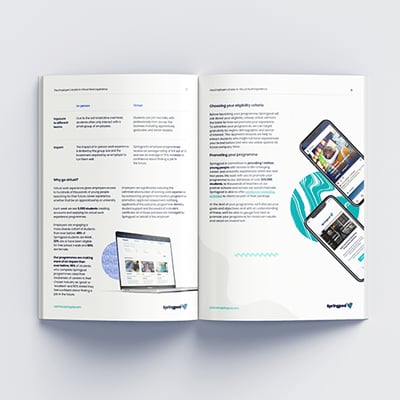
Safeguarding is an essential part of your virtual work experience programme to ensure protection for students, staff and your organisation.
We share 5 safeguarding tips you need to know:
1. Ensure you have a safeguarding policy
It may seem obvious, but when conducting virtual work experience there are a number of factors that require safeguarding that wouldn't be required when delivering in-person. This includes sharing personal data, webcam visibility and more. Whether it’s something that your organisation has created or you’re running a programme in partnership with another business, it’s important to have a policy in place for those who have queries or concerns.
For those partnering with Springpod, we have a safeguarding policy in place to protect our users during programmes, which can be found here. This way you can relax knowing that those involved are in safe hands.
2. Never share your user's data
During virtual work experience, there will be times where students will have the opportunity to engage with employers and other users. This is an essential part of enabling students to access real-life experiences and employer stories. However, it’s important to remember not to share students' email addresses, names or other identifiable data during these sessions.
3. Be careful when sharing webcams during sessions
If you’re running webinars with students, to comply with safeguarding, it’s best practice to keep webcams turned off during the sessions. The students are still able to contact the host through the chat functionality, where they can ask questions, but remain anonymous.
If you would prefer to see the students, it’s best to ask them to partake in webinars from their college or school, where they are in a classroom environment.
4. Remember to ask for parental consent
For any student who is under the age of 16, as the employer, you will require parental consent for their child to participate. If you’re working with a partner like Springpod, we ensure this happens before the students apply for a login to our site. So you’re covered.
5. Use an appropriate hosting platform
When you’re running a virtual work experience, it’s important to use a robust hosting platform to ensure the safeguarding of your cohort. Springpod’s webinars take place in a secure hosting environment that anonymises the students and allows them to participate in a safe way.
The team fully manages the process from end to end, with DBS checked administrators available during webinars to ensure interactions taking place are secure. They will also monitor for any profanity and sharing of contact details between users.
Now that you know how to safely run your virtual work experience for students, it’s time to get planning your programme.
Our complete Virtual Work Experience Toolkit includes hints and tips on boosting student engagement and activity ideas to get you started. You can download it below.

Download our free Virtual Work Experience Toolkit to find out more.
Continue reading

A Letter from our CEO, Sam Hyams



